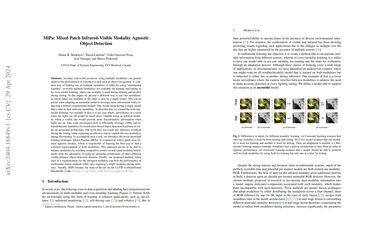MiPa: Mixed Patch Infrared-Visible Modality Agnostic Object Detection
In this paper, we present a different way to use two modalities, in which either one modality or the other is seen by a single model. This can be useful when adapting an unimodal model to leverage more information while respecting a limited computational budget. This would mean having a single model that is able to deal with any modalities. To describe this, we coined the term anymodal learning. An example of this, is a use case where, surveillance in a room when the lights are off would be much more valuable using an infrared modality while a visible one would provide more discriminative information when lights are on. This work investigates how to efficiently leverage visible and infrared/thermal modalities for transformer-based object detection backbone to create an anymodal architecture. Our work does not create any inference overhead during the testing while exploring an effective way to exploit the two modalities during the training. To accomplish such a task, we introduce the novel anymodal training technique: Mixed Patches (MiPa), in conjunction with a patch-wise domain agnostic module, which is responsible of learning the best way to find a common representation of both modalities. This approach proves to be able to balance modalities by reaching competitive results on individual modality benchmarks with the alternative of using an unimodal architecture on three different visible-infrared object detection datasets. Finally, our proposed method, when used as a regularization for the strongest modality, can beat the performance of multimodal fusion methods while only requiring a single modality during inference. Notably, MiPa became the state-of-the-art on the LLVIP visible/infrared benchmark. Code: https://github.com/heitorrapela/MiPa
PDF Abstract

